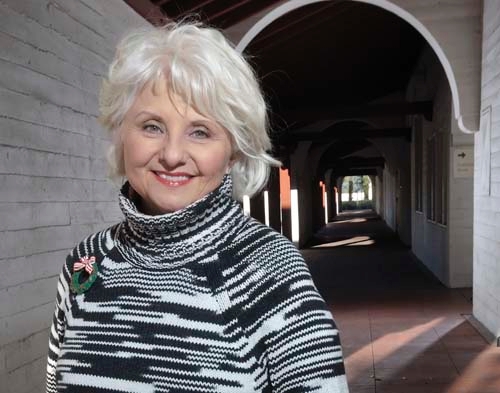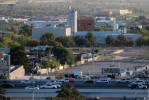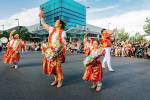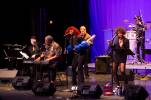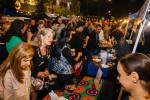New cultural director expects big things in downtown Las Vegas
It's not often that Las Vegas' downtown culture scene steals the stage from the spotlight hog that is the Strip.
But that might change in 2012, the so-called "year of downtown," and no one would be happier than Nancy Deaner.
Deaner, 62, daughter of a Las Vegas Sands card dealer, is a lifelong painter and arts lover and tireless booster of the downtown arts scene.
She also was recently ratified by the Las Vegas City Council as the official director of the Office of Cultural Services after serving as its interim director.
The job, with an annual salary of $107,229, puts Deaner in a position to make sure downtown Las Vegas makes the most of perhaps its most prominent year since the Fremont Street Experience canopy went up in the 1990s.
She's the city's liaison to nonprofit partners who will run the Mob Museum in the former federal courthouse and post office, the Neon Museum on Las Vegas Boulevard , and the Smith Center for the Performing Arts in a former brownfield near Bonneville Avenue and West Central Parkway.
It's a long time coming for Deaner, who got bachelor's and master's degrees in fine arts from the University of Nevada, Las Vegas and has worked in the city's cultural affairs department since 1994.
She's looking forward to seeing the new additions combine with the Fremont East Entertainment District and 18b Arts District to form a cohesive, vibrant downtown fabric that's based on art, entertainment, culture and music.
"It will knit together and fill in all of downtown," Deaner says. "The fabric is getting tighter."
Deaner recently took time to talk with the Review-Journal about why arts and culture downtown are important to the city as a whole. The interview was edited for length and clarity.
R-J: Most communities aren't building museums to look at the history of organized crime or neon signs. Do you find yourself defending the cultural significance of those to people?
ND: Yes, I've had to defend it. And I am always so shocked when I have to defend it to people who live here. This is who we are. This is who we should celebrate.
The first time I gave a Smithsonian cultural tour, they really wanted to see where the neon signs are, Fremont Street. As I took them through every sign, I realized I was giving them a complete history of the city of Las Vegas, of buildings and places that were no longer there but told the story of who we were. Every one of those signs, all of those fonts, talk about the decade they were built in. It is like the CliffsNotes version of graphics design in America. People from all over the world come to look at it for that reason.
The Mob Museum, that is another very interesting project. When we first started that project, the main thing that everybody said was that it has to be the actual truth, it can't be glamorized, it can't be gilded. This one is really an accurate story of this community. It also serves the function of saving a historic building, so it is a double whammy.
The roundabout answer to that question is, yes I've had to defend both projects and I'm always a little surprised, not as much with the Mob Museum because of the name.
R-J: Where does the symphony hall fit in? What is the Las Vegas significance to that? Why would the city get involved in that when there are plenty of venues around town spending their own money to have shows and concerts?
ND: There is a huge difference between the Smith Center and what they are doing in the casinos and hotels. First of all, if you go to a Broadway show at the Smith Center, it is the full unadulterated version of the Broadway show. If you go to a Broadway show on the Strip, it is often truncated because they don't want you in the show too long, they want you out in the casino. The Smith Center will provide a huge educational tool for the cultural community and the casinos obviously don't do that.
R-J: Is it difficult to explain to people or challenging to explain to people all these things, these museums coming up online at a time when city government is generally paring back, people's salaries are being cut, people are being laid off, taxpayers are coming to expect reduced frequency of different services?
ND: The simple answer there is these projects were so far along, the Neon Museum has been in the works for 20 years. When the recession hit these projects were far enough along to say we are going to open them. Now, isn't it great that we have them because they will help diversify and broaden the tax base, they are wonderful things. Actually in hindsight you could say we were geniuses, but we just got really lucky.
R-J: Why is the cultural affairs department important and why should local government support art?
ND: What we do is nurture and incubate arts programs with the hope that the community takes it on and embraces it, that is really our goal. As the city matures, because it is growing up, then the goal is to have endowments and nonprofits that are supported by the community itself.
R-J: What are your goals for your department?
ND: The arts are unique in that they really do sit at the intersection of quality-of-life issues and economic development. We're addressing the quality-of-life issues. Educated populations want to live in communities where there are cultural amenities.
My goal internally is to work closer with the department of economic and urban development so we can just work together on making a lot of this happen. I'd love to be able to start working on an arts museum before I left. That would be a goal.
R-J: What's your earliest significant experience that you would say is uniquely Las Vegas?
ND: I remember going with my mother to drive my father to work at the Sands Hotel at like midnight and that was just par for the course, to be really late. Then I went back to Kentucky with some family friends. We got in at nine o'clock at night and this little town was pitch dark, I thought, what's wrong? Is there a power outage? They didn't have lights, they didn't have slot machines and they weren't open 24 hours.
R-J: You said recently it is a great time to live in Las Vegas. Why? That is counter to popular perception.
ND: I understand that popular perception is based on the sale of homes and all that. I get that. I think the arts are getting ready to just burst forward here. I think there are a lot of jobs, work and viable businesses that will spring forth because of everything that is going to happen down here.
R-J: Can artists or art projects that receive money from the government ever be independent artistically and defiant and those things that people expect out of art? Or does working together with the government make that impossible?
ND: There are constraints when you take money from government. If you want to do a certain kind of art and you're going to take money from a government you need to have your eyes open and understand that you are going to face some issues with it. If you don't you are very naive. I am the first person that will tell you if you are going to come to me and say, "Wow, I do this real experimental type of orgy on the stage and is that OK?" I'm going to say, "No, it is not." If you are an artist and you have a certain edge and you know it is going to be offensive then you have to be ready to either a.) not get funding or b.) be ready to be raked over the coals for the funding you get.
Contact reporter Benjamin Spillman at
bspillman@reviewjournal.com or 702-229-6435.



